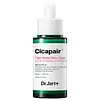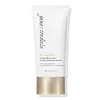Dr. Jart+ Cicapair Tiger Grass Camo Drops Color Corrector SPF 35 Versus Jane Iredale Dream Tint Tinted Moisturizer SPF 15
What's inside
What's inside
 Key Ingredients
Key Ingredients

 Benefits
Benefits

 Concerns
Concerns

 Ingredients Side-by-side
Ingredients Side-by-side

Water
Skin ConditioningCyclopentasiloxane
EmollientIsononyl Isononanoate
EmollientPentaerythrityl Tetraisostearate
EmollientButyloctyl Salicylate
Skin ConditioningMethyl Trimethicone
Skin ConditioningIsododecane
EmollientDipropylene Glycol
HumectantDiphenylsiloxy Phenyl Trimethicone
Skin ConditioningLauryl PEG-10 Tris(Trimethylsiloxy)Silylethyl Dimethicone
EmulsifyingMethyl Methacrylate Crosspolymer
Acrylates/Dimethicone Copolymer
Skin ConditioningNiacinamide
SmoothingPolymethylsilsesquioxane
Disteardimonium Hectorite
StabilisingPolyglyceryl-4 Isostearate
EmulsifyingMagnesium Sulfate
Dipentaerythrityl Hexahydroxystearate/Hexastearate/Hexarosinate
Skin ConditioningBeeswax
Emulsion Stabilising1,2-Hexanediol
Skin ConditioningTriethoxycaprylylsilane
Centella Asiatica Extract
CleansingCaprylyl Glycol
EmollientSynthetic Fluorphlogopite
Glyceryl Caprylate
EmollientZein
Skin ConditioningEthylhexylglycerin
Skin ConditioningSilica Dimethyl Silylate
EmollientAluminum Hydroxide
EmollientAdenosine
Skin ConditioningLavandula Angustifolia Oil
MaskingZea Mays Starch
AbsorbentCitrus Paradisi Peel Oil
MaskingHydrogenated Lecithin
EmulsifyingRosmarinus Officinalis Leaf Oil
MaskingCaprylic/Capric Triglyceride
MaskingHelianthus Annuus Seed Oil
EmollientSodium Chloride
MaskingDipotassium Phosphate
BufferingCalcium Stearate
Cosmetic ColorantGossypium Herbaceum Seed Oil
Skin ConditioningAnthemis Nobilis Flower Oil
MaskingPanthenol
Skin ConditioningButylene Glycol
HumectantAnastatica Hierochuntica Extract
AstringentHouttuynia Cordata Extract
Skin ConditioningAniba Rosaeodora Wood Oil
AstringentCitral
PerfumingPentylene Glycol
Skin ConditioningZinc Gluconate
Skin ConditioningMagnesium Aspartate
Skin ConditioningLecithin
EmollientGlycerin
HumectantBrassica Campestris Sterols
EmollientAlcohol
AntimicrobialSucrose Laurate
EmollientPolyglyceryl-2 Caprate
EmulsifyingLeuconostoc/Radish Root Ferment Filtrate
AntimicrobialArnica Montana Flower Extract
MaskingCentella Asiatica Leaf Extract
Skin ConditioningFragaria Vesca Fruit Extract
AstringentCopper Gluconate
Skin ConditioningLysolecithin
EmulsifyingCeramide NP
Skin ConditioningLimonene
PerfumingLinalool
PerfumingCaprylhydroxamic Acid
Madecassoside
AntioxidantTocopherol
AntioxidantSodium Ascorbyl Phosphate
AntioxidantPhenoxyethanol
PreservativeCI 77891
Cosmetic ColorantCI 77491
Cosmetic ColorantCI 77492
Cosmetic ColorantCI 77288
Cosmetic ColorantWater, Cyclopentasiloxane, Isononyl Isononanoate, Pentaerythrityl Tetraisostearate, Butyloctyl Salicylate, Methyl Trimethicone, Isododecane, Dipropylene Glycol, Diphenylsiloxy Phenyl Trimethicone, Lauryl PEG-10 Tris(Trimethylsiloxy)Silylethyl Dimethicone, Methyl Methacrylate Crosspolymer, Acrylates/Dimethicone Copolymer, Niacinamide, Polymethylsilsesquioxane, Disteardimonium Hectorite, Polyglyceryl-4 Isostearate, Magnesium Sulfate, Dipentaerythrityl Hexahydroxystearate/Hexastearate/Hexarosinate, Beeswax, 1,2-Hexanediol, Triethoxycaprylylsilane, Centella Asiatica Extract, Caprylyl Glycol, Synthetic Fluorphlogopite, Glyceryl Caprylate, Zein, Ethylhexylglycerin, Silica Dimethyl Silylate, Aluminum Hydroxide, Adenosine, Lavandula Angustifolia Oil, Zea Mays Starch, Citrus Paradisi Peel Oil, Hydrogenated Lecithin, Rosmarinus Officinalis Leaf Oil, Caprylic/Capric Triglyceride, Helianthus Annuus Seed Oil, Sodium Chloride, Dipotassium Phosphate, Calcium Stearate, Gossypium Herbaceum Seed Oil, Anthemis Nobilis Flower Oil, Panthenol, Butylene Glycol, Anastatica Hierochuntica Extract, Houttuynia Cordata Extract, Aniba Rosaeodora Wood Oil, Citral, Pentylene Glycol, Zinc Gluconate, Magnesium Aspartate, Lecithin, Glycerin, Brassica Campestris Sterols, Alcohol, Sucrose Laurate, Polyglyceryl-2 Caprate, Leuconostoc/Radish Root Ferment Filtrate, Arnica Montana Flower Extract, Centella Asiatica Leaf Extract, Fragaria Vesca Fruit Extract, Copper Gluconate, Lysolecithin, Ceramide NP, Limonene, Linalool, Caprylhydroxamic Acid, Madecassoside, Tocopherol, Sodium Ascorbyl Phosphate, Phenoxyethanol, CI 77891, CI 77491, CI 77492, CI 77288
Titanium Dioxide 5%
Cosmetic ColorantWater
Skin ConditioningStearic Acid
CleansingCaprylic/Capric Triglyceride
MaskingOctyldodecyl Neopentanoate
EmollientLeuconostoc/Radish Root Ferment Filtrate
AntimicrobialLactobacillus Ferment
Skin ConditioningGlycerin
HumectantGlyceryl Stearate
EmollientSimmondsia Chinensis Seed Oil
EmollientGlyceryl Acrylate/Acrylic Acid Copolymer
HumectantSpirulina Platensis Extract
Skin ProtectingHydrolyzed Rhodophyceae Extract
Carthamus Tinctorius Seed Oil
MaskingHelianthus Annuus Seed Oil
EmollientSambucus Nigra Extract
Skin ConditioningBoron Nitride
AbsorbentMica
Cosmetic ColorantButyrospermum Parkii Butter
Skin ConditioningCamellia Sinensis Leaf Extract
AntimicrobialVitis Vinifera Seed Extract
AntimicrobialPunica Granatum Extract
AstringentLavandula Angustifolia Oil
Masking1,2-Hexanediol
Skin ConditioningPolyhydroxystearic Acid
EmulsifyingAlumina
AbrasiveLinalool
PerfumingLimonene
PerfumingGeraniol
PerfumingCI 77489
Cosmetic ColorantCI 77491
Cosmetic ColorantCI 77492
Cosmetic ColorantCI 77499
Cosmetic ColorantCI 77288
Cosmetic ColorantTitanium Dioxide 5%, Water, Stearic Acid, Caprylic/Capric Triglyceride, Octyldodecyl Neopentanoate, Leuconostoc/Radish Root Ferment Filtrate, Lactobacillus Ferment, Glycerin, Glyceryl Stearate, Simmondsia Chinensis Seed Oil, Glyceryl Acrylate/Acrylic Acid Copolymer, Spirulina Platensis Extract, Hydrolyzed Rhodophyceae Extract, Carthamus Tinctorius Seed Oil, Helianthus Annuus Seed Oil, Sambucus Nigra Extract, Boron Nitride, Mica, Butyrospermum Parkii Butter, Camellia Sinensis Leaf Extract, Vitis Vinifera Seed Extract, Punica Granatum Extract, Lavandula Angustifolia Oil, 1,2-Hexanediol, Polyhydroxystearic Acid, Alumina, Linalool, Limonene, Geraniol, CI 77489, CI 77491, CI 77492, CI 77499, CI 77288
 Reviews
Reviews

Ingredients Explained
These ingredients are found in both products.
Ingredients higher up in an ingredient list are typically present in a larger amount.
1,2-Hexanediol is a synthetic liquid and another multi-functional powerhouse.
It is a:
- Humectant, drawing moisture into the skin
- Emollient, helping to soften skin
- Solvent, dispersing and stabilizing formulas
- Preservative booster, enhancing the antimicrobial activity of other preservatives
This ingredient is an emollient, solvent, and texture enhancer. It is considered a skin-softener by helping the skin prevent moisture loss.
It helps thicken a product's formula and makes it easier to spread by dissolving clumping compounds.
Caprylic Triglyceride is made by combining glycerin with coconut oil, forming a clear liquid.
While there is an assumption Caprylic Triglyceride can clog pores due to it being derived from coconut oil, there is no research supporting this.
Learn more about Caprylic/Capric TriglycerideCi 77288 is used to add green pigment to products.
Ci 77491 is also hydrated iron III oxide. It's sole purpose is to give a red/pink hue to products.
Iron III oxides are classified as inorganic chemicals for coloring.
Synthetically created Ci 77491 is considered safer than those naturally found. This is because the synthetically created version may contain less impurities. Iron oxides are generally non-toxic and non-allergenic.
Learn more about CI 77491Ci 77492 is also hydrated iron III oxide. It's sole purpose is to give a yellow hue to products.
Iron III oxides are classified as inorganic chemicals for coloring.
Synthetically created Ci 77492 is considered safer than those naturally found. This is because the synthetically created version may contain less impurities. Iron oxides are generally non-toxic and non-allergenic.
Learn more about CI 77492Glycerin is already naturally found in your skin. It helps moisturize and protect your skin.
A study from 2016 found glycerin to be more effective as a humectant than AHAs and hyaluronic acid.
As a humectant, it helps the skin stay hydrated by pulling moisture to your skin. The low molecular weight of glycerin allows it to pull moisture into the deeper layers of your skin.
Hydrated skin improves your skin barrier; Your skin barrier helps protect against irritants and bacteria.
Glycerin has also been found to have antimicrobial and antiviral properties. Due to these properties, glycerin is often used in wound and burn treatments.
In cosmetics, glycerin is usually derived from plants such as soybean or palm. However, it can also be sourced from animals, such as tallow or animal fat.
This ingredient is organic, colorless, odorless, and non-toxic.
Glycerin is the name for this ingredient in American English. British English uses Glycerol/Glycerine.
Learn more about GlycerinHelianthus Annuus Seed Oil is the oil derived from the seeds of a Sunflower. Sunflower seed oil is non-fragrant. It is an emollient, meaning it helps to soften the skin.
Sunflower seed oil contains many fatty acids. The fatty acids found in sunflower seeds include (from highest amount to least): linoleic acid, myristic acid, palmitic acid, stearic acid, arachidic acid, oleic acid, and linolenic acid.
These fatty acids help the skin create ceramides. Ceramides play a role in repairing the skin barrier.
Helianthus Annuus Seed Oil helps moisturize the skin. This in turn helps the skin look more rejuvenated and smoother.
Sunflowers are rich in vitamin E.
Historians believe Indigenous cultures of North America domesticated sunflowers before corn. Thus they relied on sunflower oil for a variety of uses. One such use is moisturizing skin and hair.
Sunflower seed oil may not be fungal acne safe. We recommend speaking with a professional if you have any concerns.
Learn more about Helianthus Annuus Seed OilLavandula Angustifolia Oil is more commonly known as lavender essential oil. It is considered a fragrancing ingredient.
Lavender imparts a famous scent. While the smell is lovely, this ingredient and may sensitize skin in topical products. This is because about 85% of the oil is made up of linalool and linalyl acetate.
When exposed to air, these two compounds become strong allergens. This ingredient exhibits cytotoxicity at low concentrations; amounts of 0.25% have been shown to damage skin cells.
A study from Japan found this ingredient caused lavender sensitivity after widespread exposure.
Lavender essential oil has some antimicrobial, antibacterial, and anti-inflammatory properties. However, the cons of this ingredient may outweight the pros.
More research is needed to confirm lavender essential oil's effects when used in aromatherapy.
Lavandula Angustifolia is known as the English Lavender and famous for creating purple fields in Provence, France.
Learn more about Lavandula Angustifolia OilLeuconostoc/Radish Root Ferment Filtrate is a natural preservative. It comes from fermenting radish roots with a bacteria called leuconostoc.
Leuconostoc comes from lactic acid.
This ingredient has antimicrobial properties and helps prevent the growth of bacteria in a product.
Leuconostoc is used to make the traditional Korean side-dish, kimchi. It is also used to make sourdough bread (both incredibly yummy foods).
Learn more about Leuconostoc/Radish Root Ferment FiltrateLimonene is a fragrance that adds scent and taste to a formulation.
It's found in the peel oil of citrus fruits and other plants such as lavender and eucalyptus. The scent of limonene is generally described as "sweet citrus".
Limonene acts as an antioxidant, meaning it helps neutralize free radicals.
When exposed to air, oxidized limonene may sensitize the skin. Because of this, limonene is often avoided by people with sensitive skin.
The term 'fragrance' is not regulated in many countries. In many cases, it is up to the brand to define this term. For instance, many brands choose to label themselves as "fragrance-free" because they are not using synthetic fragrances. However, their products may still contain ingredients such as essential oils that are considered a fragrance.
Learn more about LimoneneLinalool is a fragrance and helps add scent to products. It's derived from common plants such as cinnamon, mint, citrus, and lavender.
Like Limonene, this ingredient oxidizes when exposed to air. Oxidized linalool can cause allergies and skin sensitivity.
This ingredient has a scent that is floral, spicy tropical, and citrus-like.
Learn more about LinaloolWater. It's the most common cosmetic ingredient of all. You'll usually see it at the top of ingredient lists, meaning that it makes up the largest part of the product.
So why is it so popular? Water most often acts as a solvent - this means that it helps dissolve other ingredients into the formulation.
You'll also recognize water as that liquid we all need to stay alive. If you see this, drink a glass of water. Stay hydrated!
Learn more about Water